The Eurasian Sparrowhawk (Accipiter nisus), a compelling member of the Accipitridae family, is a small to medium-sized bird of prey that inhabits diverse ecosystems across Europe, Asia, and parts of North Africa.
Renowned for its agility and remarkable hunting abilities, this raptor navigates varied landscapes, from woodlands and urban areas to mountainous terrains.
The species exhibits sexual dimorphism, with females larger than males, showcasing intriguing roles in courtship and parenting.
Nesting in concealed locations and displaying impressive aerial acrobatics during courtship, the Eurasian Sparrowhawk captivates bird enthusiasts and researchers alike.
Recognized by six distinct subspecies, each adapted to specific regions, this bird plays a vital role in maintaining ecological balance.
As an adaptable and resilient predator, the Eurasian Sparrowhawk stands as a testament to nature’s intricate design and the dynamic interplay between species and their environments. Stay focused.
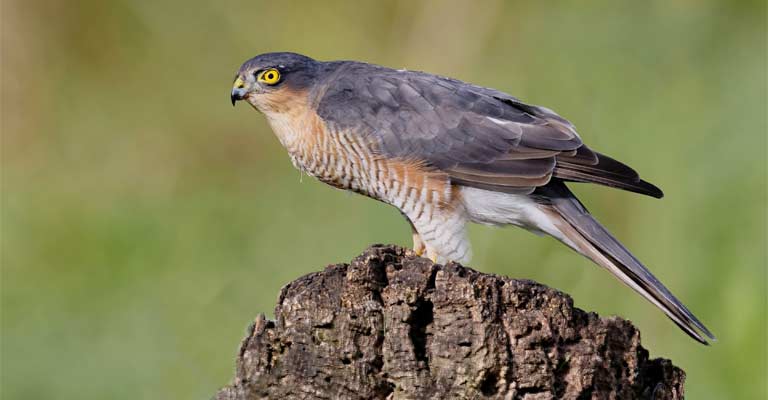
Physical Characteristics of Eurasian Sparrowhawk
The Eurasian Sparrowhawk (Accipiter nisus) is a small to medium-sized bird of prey that belongs to the Accipitridae family.
Identifying this raptor requires attention to various physical characteristics, behaviors, and habitat preferences. Here are eight key points to help you distinguish the Eurasian Sparrowhawk:
Size and Shape

The Eurasian Sparrowhawk exhibits a compact and robust build, with females being larger than males.
Adults typically have a length ranging from 28 to 38 cm (11 to 15 inches) and a wingspan of 55 to 70 cm (22 to 28 inches).
Their wings are relatively short and rounded, aiding in rapid and agile flight.
Plumage
Adult Eurasian Sparrowhawks have a distinctive plumage pattern. The upperparts are dark brown, while the underparts are barred with horizontal reddish-brown streaks.
Females tend to have a more prominent and pronounced pattern compared to males. Juveniles have a brownish plumage with vertical streaks, providing effective camouflage.
Tail and Flight Pattern
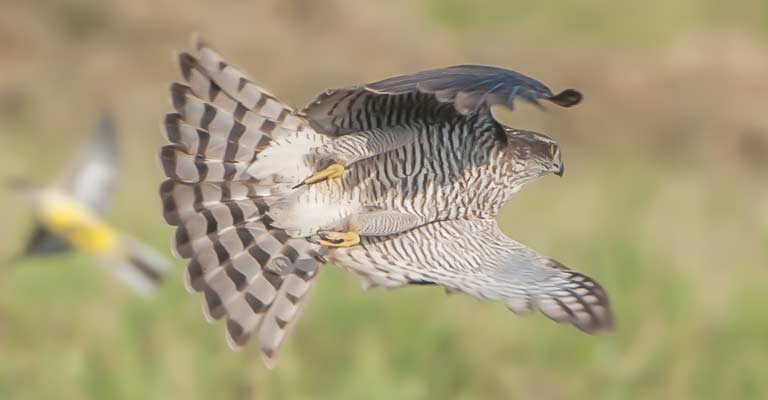
One of the key identification features is the tail. The Eurasian Sparrowhawk has a squared-off or slightly rounded tail, distinguishing it from other raptors.
During flight, they display rapid, erratic wing beats interspersed with glides. Their flight pattern often involves low-level flying through vegetation while hunting.
Facial Features
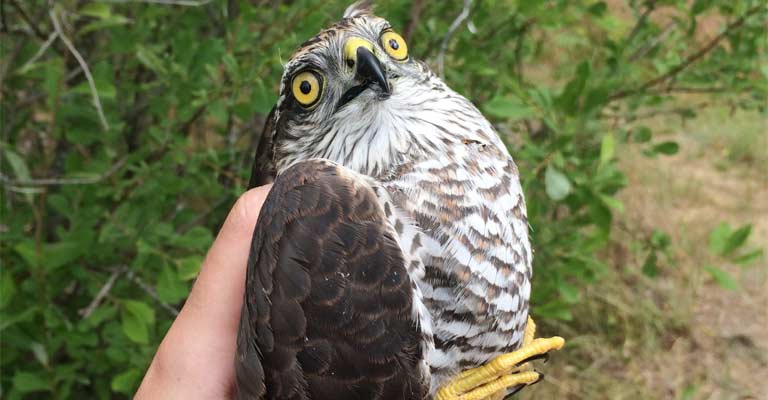
The face of the Eurasian Sparrowhawk is characterized by a distinct “eyebrow” or supercilium, which is a pale line above the eye.
The eyes are large and yellow, contributing to their keen vision. The hooked beak is sharp and well-suited for tearing into prey.
Sexual Dimorphism
Sexual dimorphism is evident in this species, with females being noticeably larger than males.
This size difference is a useful characteristic for field identification, although it may require direct comparison when observed in isolation.
Habitat and Range
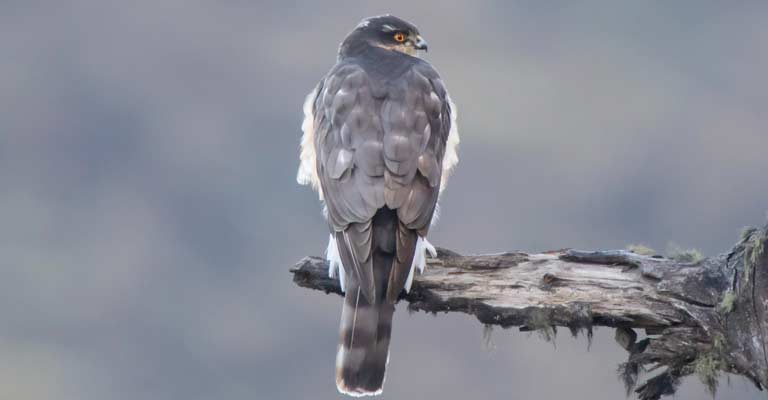
Eurasian Sparrowhawks are adaptable and can be found in a variety of habitats, including woodlands, forests, urban areas, and parks.
They are widespread throughout Europe, Asia, and parts of North Africa, and their distribution can vary based on seasonal movements and local prey availability.
Hunting Behavior
These raptors are skilled hunters who primarily prey on small birds, such as sparrows and finches.
Their hunting technique often involves surprise attacks, utilizing cover and terrain to get close to their prey before launching a swift assault.
Vocalizations
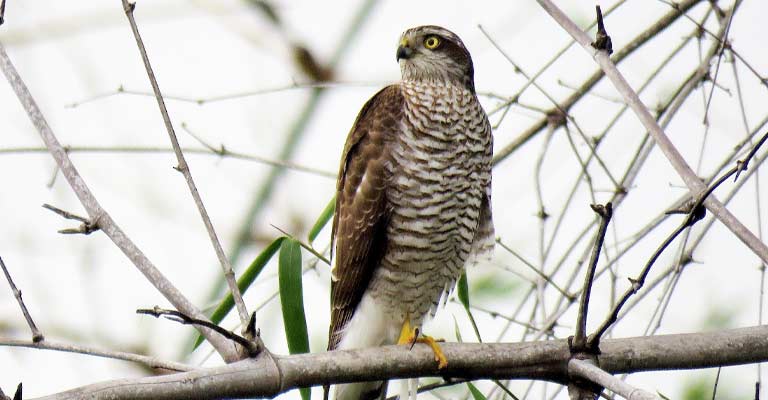
While not as distinctive as some other raptors, the Eurasian Sparrowhawk has a range of vocalizations, including a sharp, high-pitched “kek-kek-kek” call during the breeding season.
Familiarizing oneself with these vocalizations can aid in identification, especially when the bird is not visible.
A combination of size, plumage patterns, tail shape, and behavioral observations can help birdwatchers and enthusiasts confidently identify the Eurasian Sparrowhawk in various habitats.
Taxonomy of Eurasian Sparrowhawk
Here is a table outlining the taxonomy details of the Eurasian Sparrowhawk:
| Taxonomic Rank | Classification |
| Domain | Eukaryota |
| Kingdom | Animalia |
| Phylum | Chordata |
| Class | Aves |
| Order | Accipitriformes |
| Family | Accipitridae |
| Genus | Accipiter |
| Species | A. nisus |
The Eurasian Sparrowhawk (Accipiter nisus) is a versatile species with six recognized subspecies, each contributing unique characteristics to the overall diversity of this raptor.
- A. n. nisus: The nominate subspecies, breeding across Europe, West Asia, western Siberia, and Iran. It showcases a remarkable migratory behavior, with northern populations wintering in regions extending from the Mediterranean to Northeast Africa, Arabia, and Pakistan.
- A. n. nisosimilis: Described by Samuel Tickell, this subspecies breeds in central and eastern Siberia, extending to Kamchatka and Japan. It is wholly migratory, wintering from Pakistan and India to Southeast Asia, southern China, Korea, and even Africa. Slightly larger than the nominate subspecies, it embodies adaptability and long-distance travel.
- A. n. melaschistos: Breeding in mountainous regions from Afghanistan to western China, this subspecies winters in the plains of South Asia. Larger and longer-tailed than nisosimilis, it features dark slate-colored upperparts and distinct rufous barring on the underparts, showcasing its adaptation to varied terrains.
- A. n. wolterstorffi: Resident in Sardinia and Corsica, this subspecies, described by Otto Kleinschmidt, is the smallest among its counterparts. Distinguished by darker upper parts and more pronounced barring below, it reflects the adaptations of insular environments.
- A. n. granti: Confined to Madeira and the Canary Islands, this subspecies, described by Richard Bowdler Sharpe, is characterized by its small size and dark plumage. Its restricted range highlights the challenges and unique adaptations of island ecosystems.
- A. n. punicus: Described by Erlanger, this resident subspecies in Northwest Africa north of the Sahara closely resembles nisus, being large and pale. Its presence in North Africa adds to the geographical diversity within the Eurasian Sparrowhawk species.
These subspecies collectively contribute to the rich tapestry of the Eurasian Sparrowhawk’s distribution, highlighting the adaptability and diversity of this remarkable bird of prey across various landscapes.
Eurasian Sparrowhawk Life History
The Eurasian Sparrowhawk (Accipiter nisus) is a fascinating bird of prey that inhabits a diverse range of environments across Europe, Asia, and parts of North Africa.
Understanding the life history of this species involves delving into its food habits, preferred habitats, range map, nesting behaviors, breeding patterns, susceptibility to diseases, treatment efforts, and conservation status.
Food
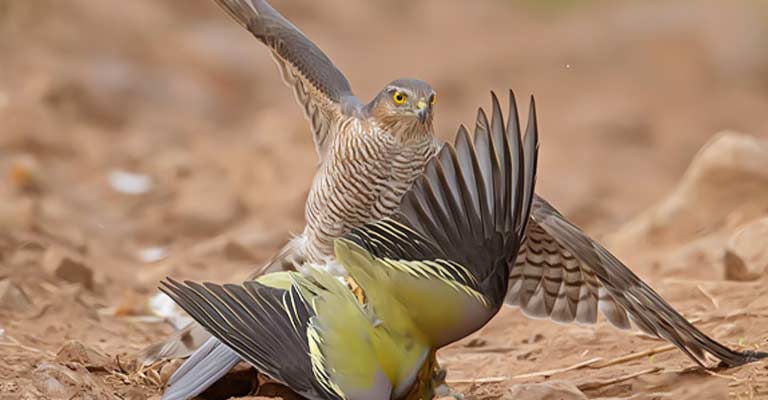
The Eurasian Sparrowhawk is a carnivorous predator with a diet primarily consisting of small birds.
Their remarkable agility and sharp talons enable them to capture a variety of prey, including sparrows, finches, thrushes, and other small passerines.
While birds constitute the main portion of their diet, occasionally, they may also hunt small mammals, insects, or even bats.
Habitat
This adaptable species is found in a diverse array of habitats, ranging from woodlands and forests to urban areas and parks.
They display a preference for areas with abundant vegetation, providing both cover for hunting and suitable nesting sites. The flexibility in their habitat choice contributes to their wide distribution.
Range Map
The Eurasian Sparrowhawk’s range extends across Europe, Asia, and North Africa. Their distribution varies seasonally, with some populations undergoing migratory movements.
A range map provides a visual representation of their geographical distribution, highlighting the regions where they are commonly found.
Nesting
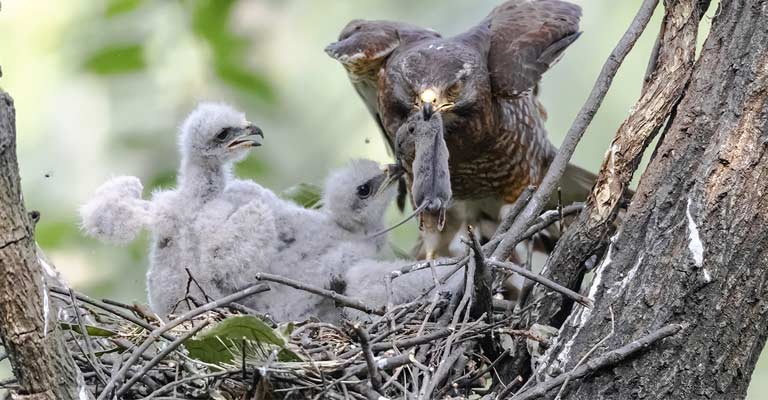
Breeding pairs of Eurasian Sparrowhawks construct nests in trees, often hidden among foliage for protection. The nests are typically made of sticks and lined with softer materials like leaves or moss.
The female takes the lead in nest building, while the male contributes by providing materials. Nest sites are defended vigorously, and pairs may reuse the same site in successive breeding seasons.
Here’s a table summarizing the nesting details of the Eurasian Sparrowhawk (Accipiter nisus):
| Nesting Details | Information |
| Clutch Size | 3 to 7 eggs |
| Number of Broods | Typically one brood per breeding season |
| Egg Length | Approximately 39 mm (1.54 inches) |
| Egg Width | Approximately 31 mm (1.22 inches) |
| Incubation Period | Around 32 days, both parents share incubation duties |
| Nestling Period | Approximately 28 to 35 days, fledging occurs at around 3 weeks |
| Egg Description | Pale bluish-white or greenish-white with minimal spotting or markings |
These details provide insight into the reproductive biology of the Eurasian Sparrowhawk, highlighting aspects such as clutch size, incubation and nestling periods, as well as the physical characteristics of their eggs.
Breeding
Breeding occurs in spring, and courtship displays involve impressive aerial acrobatics. After successful copulation, the female lays a clutch of eggs, usually ranging from 3 to 7.
Both parents participate in incubating the eggs and later caring for the chicks. The young birds fledge after about three weeks but remain dependent on their parents for some time.
Diseases
Eurasian Sparrowhawks may be susceptible to various diseases, including avian influenza and trichomoniasis.
These diseases can impact their health and reproductive success. Monitoring for signs of illness, such as lethargy or abnormal behavior, is crucial for early detection.
Treatment
In cases of disease outbreaks, conservationists and wildlife veterinarians implement treatment measures.
These may include quarantine, administration of medication, and, in severe cases, rehabilitation efforts. Preventive measures, such as monitoring and maintaining overall habitat health, are also crucial for minimizing disease risks.
Conservation
The Eurasian Sparrowhawk is generally considered a species of least concern on the conservation scale. However, habitat loss, pesticide exposure, and illegal persecution pose localized threats.
Conservation efforts focus on protecting their habitats, raising awareness about the importance of these raptors in ecosystems, and implementing measures to minimize human-induced threats.
The life history of the Eurasian Sparrowhawk is a testament to its adaptability and ecological significance.
By understanding and addressing the various aspects of their biology, from feeding habits to conservation needs, we can contribute to the continued survival and well-being of this captivating bird of prey.
10 Surprising Facts About Eurasian Sparrowhawk
The Eurasian Sparrowhawk (Accipiter nisus) is a captivating bird of prey that often eludes our attention despite its widespread distribution.
Here are 10 surprising facts about this enigmatic raptor that showcase its remarkable characteristics and behaviors.
- Size Deception: Despite its relatively small size compared to other raptors, the Eurasian Sparrowhawk is a formidable hunter. The females, in particular, can take down prey larger than themselves, showcasing their agility and predatory prowess.
- Urban Predators: Unlike many birds of prey, Eurasian Sparrowhawks have adapted well to urban environments. They are known to hunt in gardens and parks, demonstrating their ability to thrive amidst human habitation.
- Males’ Sky-High Display: During courtship, male Eurasian Sparrowhawks engage in impressive aerial displays that include steep climbs and dives. These acrobatics serve both as a courtship ritual and a way to establish territories.
- Subtle Supermom: Female Eurasian Sparrowhawks are significantly larger than males. This size difference is not just for show; it allows the females to provide better protection and support for their young, showcasing an intriguing role reversal in avian biology.
- Master of Ambush: These raptors are adept at using cover and vegetation for surprise attacks. Their hunting strategy often involves ambushing small birds, utilizing the element of surprise and their swift, agile flight.
- Camouflaged Nesting: Nesting Eurasian Sparrowhawks employ excellent camouflage skills. Their nests are well-hidden among foliage in trees, making it challenging for predators and human observers to detect.
- Falconry Fame: Historically, Eurasian Sparrowhawks were popular in falconry due to their agility and versatility in hunting small game. Falcons of this species were highly prized for their prowess in pursuing fast, elusive prey.
- Egg Variation: The coloration of Eurasian Sparrowhawk eggs can vary. While they are generally bluish-white or greenish-white, variations exist, and some eggs may exhibit subtle spots or markings.
- Conservation Adaptability: Despite facing localized threats such as habitat loss, Eurasian Sparrowhawks are generally adaptable and have shown resilience. They continue to thrive in a variety of habitats, contributing to their conservation status of least concern.
- Pint-sized Longevity: While smaller raptors often have shorter lifespans, Eurasian Sparrowhawks can live relatively long lives in the wild. Some individuals have been recorded living up to 10 years or more, showcasing their ability to navigate the challenges of their environment.
These surprising facts about the Eurasian Sparrowhawk underscore its unique characteristics, adaptability, and the vital role it plays in various ecosystems.
Observing these behaviors adds depth to our understanding of this often-overlooked bird of prey.
Wrapping Up
In the intricate tapestry of avian life, the Eurasian Sparrowhawk stands as a compelling and adaptable predator, weaving surprises into its behavior and biology.
From urban hunters to aerial acrobats, these raptors captivate with their size, courtship rituals, and surprising roles in avian parenting.
Their resilience in the face of environmental challenges and their ability to thrive in diverse habitats make them not just subjects of fascination but vital contributors to the ecosystems they inhabit. Thank you so much.